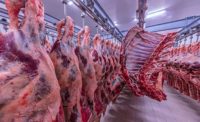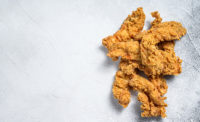Keeping meat and poultry safe during the grinding, mixing and stuffing processes can be difficult.
Rising temperatures from friction in the machinery during processing creates an environment that is conducive to the growth of pathogens, while objects originating from workers, machinery and facilities also pose contamination threats.
“The grinding process can spread pathogens throughout each lot of ground beef and between lots if grinding equipment and/or food contact surfaces are not properly cleaned,” reports the U.S. Department of Agriculture’s Food Safety and Inspection Service (FSIS). “The cleaning and sanitizing of equipment used to grind raw beef is important because it prevents the transfer of E. coli O157:H7 and other bacteria from one lot of product to another.”
“Grinding is a violent process and one small area of a carcass or a combo that might be contaminated can be distributed throughout the entire batch,” says Gregg Rentfrow, extension professor, in the Department of Animal and Food Sciences at the College of Agriculture, Food and Environment at the University of Kentucky, in Lexington. “We’re fighting an invisible enemy, which makes it even more challenging.”
Other microorganisms, such as Salmonella and Campylobacter, which are on the outer surfaces of meat and poultry cuts, also have an excellent opportunity to mix throughout the product, says Nicole Keresztes-James, technical manager of food equipment at NSF International, an Ann Arbor, Mich.-based certification organization that does supply-chain assurance and second- and third-party auditing for food manufacturing and processing companies.
“There may also be a higher degree of employee involvement and handling at the grinding and stuffing stage, which then introduces the food-safety threats related to personal hygiene,” she says.
In addition, grinding and stuffing often adds new ingredients to the process flow, which enhances the risk of having allergens present in the product but not on the product label, James says.
GET RELIEF FROM THE HEAT
To help minimize the threat of pathogens, it is important for operators to feed meat and poultry into the mouth of grinders at rates and amounts that prevent clogging so the cold proteins steadily enter the system and help lower processing temperatures, says Norman Marriott, emeritus professor in the College of Agriculture and Life Sciences at Virginia Polytechnic Institute and State University, in Blacksburg.
Maintaining sharp cutting blades so operations are quicker and more efficient also will slow temperature increases, he says, adding that processors can use carbon dioxide to further cool products, which can increase in temperature from 40 degrees Fahrenheit to 170 degrees Fahrenheit during processing.
In addition, grocery operators that grind in-house can control temperatures by situating the equipment in coolers, Rentfrow says. “The temperature increase in grinding is not as high when the metal and meat block stay cold,” he says.
To further reduce heat buildup, Schweid & Sons, a Carlstadt, N.J.-based ground beef purveyor with plants in Carlstadt and College Park, Ga., uses a chilling system in its grinders and mixers to help ensure blending occurs at proper temperatures, says Jamie Schweid, president and chief executive officer.
Operators also must be cautious about leaving plant doors open on hot days to prevent the creation of more heat during grinding, he says.
HOW TO DEAL WITH THE DANGERS
Along with bacteria, the prospect of foreign objects contaminating meat and poultry is a major grinding and stuffing threat. The metal-on-metal rubbing of grinding equipment, for instance, may produce metal shavings that can adulterate products, while bone fragments from carcasses and rubber, plastic or wood pieces from the facility may also mix with proteins and be difficult to detect, Keresztes-James says.
Marriott says workers also can drop items such as glasses, watches, tools and even helmets into grinders, “which not only contaminates the product, but can dull the machine blade and damage the equipment.” The use of shields over the grinders can help guard the meat and poultry from such articles, he says.
Schweid & Sons has automated processing systems that limit the chance foreign objects will originate from workers, Schweid says. In addition, bone-collection systems remove potential contaminants larger than 1/8th of an inch from grinds, including ligaments and cartilages, and metal detectors scan for contaminants at the end of every processing line, he says.
Quality assurance workers test the detectors daily for accuracy and review monitor calibration monthly, Schweid says. “The last thing you want is a customer finding a screw or other item in their product,” he says. “That would be a really bad situation.”
STICK TO THE SAFETY PROGRAM
Implementing a food-safety plan that emphasizes prevention is key to reducing such menaces, Keresztes-James says. There also should be processes in place to test for pathogens in the raw materials coming from suppliers and to ensure grinding and stuffing equipment remains sanitary, she says.
“A strong preventative maintenance program that proactively manages the condition of the equipment and not just reacts to immediate repair issues goes a long way to reducing the introduction of hazards to the product,” Keresztes-James says.
Spraying raw materials with antimicrobials prior to grinding helps reduce the threat of contamination in Schweid & Sons’ plants, Schweid says. The operator also spot checks meats for bacteria upon arrival from packers, he says, noting grinds are more at risk for E.coli and other pathogens than cuts from which potentially contaminated surface meat can be trimmed, such as steaks.
EMPLOYEE TRAINING CAN WORK WONDERS
Ensuring workers understand the importance of food safety during grinding and stuffing also is critical for reducing incidents, Rentfrow says. “Processors need to incorporate a food-safety mindset in their employees and develop a culture where everyone understands why it is important and how they can be active participants in initiatives,” he says.
Proper training is essential to ensure workers properly use and maintain grinding and stuffing equipment, Marriott says. It’s also important to have supervisors monitor performance to keep employees from becoming careless.
“Workers should be dependable and trainable, and most will respond better if operators show them how to do the procedures, and then follow up with supervision to be certain they are performing the activities correctly,” Marriott says.
Processors can further safeguard processes by staying abreast of the evolving governmental requirements for managing grinding and mixing operations, Keresztes-James says. “Given that ground and stuffed meat and poultry products have such significant food safety threats, the level of regulatory oversight is significant,” she says. “Keeping up with regulatory expectations, both for the domestic market as well as exports, along with customer requirements, is a daunting task.” NP





Report Abusive Comment